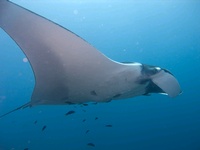
Manta Rays may have evolved from bottom feeding ancestors but have adapted to become filter feeders in the open ocean. This has allowed them to grow to a larger size than any other species of ray. Because of their pelagic lifestyle as plankton feeders, some of the ancestral characterstics have degenerated. For example, all that is left of their oral teeth is a small band of vestigial teeth on the lower jaw, almost hidden by the skin. Their dermal denticals are also greatly reduced in number and size, but are still present, and they have a much thicker body mucus coating than other rays. Their spiracles have become small and non-functional, as all water is taken in through their mouth instead. To swim better through the ocean, they have a diamond shaped body plan, using their pectoral fins as graceful "wings". Mantas generally eat plankton, fish larvae and small organisms that are filtered out from the water by their gill rakers, a type of filter feeding that is called ram-jet feeding. The predators of the Manta Ray include mainly large sharks, however in some circumstances killer whales have also been observed preying on them. Taxonomically, the situation of the mantas is still under investigation. Three species have been identified: Manta birostris, Manta ehrenbergii, and Manta raya, but they are quite similar to each other, and the last two may just be isolated populations. The genus Manta is sometimes placed in its own family, Mobulidae, but this article follows FishBase, and places it in the family Myliobatidae, with the eagle rays and their relatives. Mantas have been given a variety of common names, including Atlantic manta, Pacific manta, devil ray, devilfish, and just manta. Some people just call all members of the family stingrays. Mantas also seem to recognize certain areas in coral reefs that harbor a certain type of fish. The mantas slow down and the fish swim inside the manta`s gills to clean it of parasites. Mantas are extremely curious of humans, and are fond of swimming with scuba divers. They have the biggest brains of any fish.